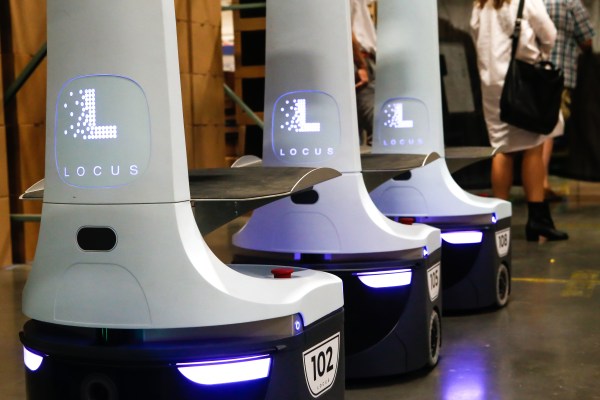Locus Robotics today unveiled a navigational system that makes it possible for their LocusBots to work more effectively together, and alongside humans in crowded, bustling warehouses. The LRAN system, which stands for Locus Robotics Advanced Navigation, debuted at the industry trade show ProMat in Chicago.
Locus Robotics formed after Amazon acquired Kiva Systems, like its competitors Fetch Robotics and 6 River Systems. The company’s founders, Bruce Welty and Mike Johnson, had been operating third-party fulfillment centers for online retailers powered by Kiva’s robots, among other technologies. But when Amazon stopped selling Kiva’s robots, and made them proprietary, they found themselves in need of tools to help associates get done quickly the job of picking and packing orders.
Generally, LocusBots can rove autonomously through warehouses and find a position near a shelf where an item requires picking by an associate. Once loaded by a person, the robots carry items from the aisles to packers who put them into boxes and send them out the door.
The old navigation tech for the LocusBot worked something like Google Maps with a layer of task-planning and computer vision on top of it, explained the company’s Chief of Operations Mike Johnson. In other words, the robots had a pre-established map they’d rely on for some of their routing, and they’d respond to data coming through cameras and other on-board sensors locally.
Now, the LocusBots with the upgraded LRAN system can communicate with one another about the various structures, obstacles, people and events they observe. This data fusion allows each robot to have a more comprehensive understanding of what’s happening in the environment where they work. It also allows the robots to be more reactive, avoiding bumping into people or each other much the way that people avoid each other in crowded streets or hallways.
The new navigation tech also allows the LocusBots to gather, like a brood of baby birds asking to be fed, and to patiently wait until they get their worms. This can help increase productivity of human workers.
Johnson explained the reason the company upgraded its system has to do with the growth of e-commerce and evolution of warehouse automation. “E-commerce fulfillment is a very unstructured world. The facilities are changing by the minute. You have lots of moving people, products and equipment. This poses a challenge a lot like the one you read about more often with self-driving cars. Robots have to navigate safely while making people more productive,” he said.
At ProMat, Johnson said, people have been playing with six LocusBots, trying to get them to bump into each other or a person. But with the new LRAN systems at work, the LocusBots have remained “patient” and let people and other robots pass by, or managed to find other routes around them.
